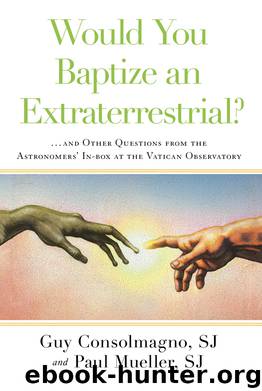Would You Baptize an Extraterrestrial? by Guy Consolmagno SJ Paul Mueller SJ

Author:Guy Consolmagno, SJ,Paul Mueller, SJ [Consolmagno, Guy]
Language: eng
Format: epub
ISBN: 978-0-8041-3696-9
Publisher: Random House Inc.
Published: 2014-10-06T16:00:00+00:00
GALILEAN ENTANGLEMENT
PAUL: There’s something fundamental about the Galileo story, however, that I’d like to develop more. The Galileo Affair shows what can go wrong when philosophy, politics, and personalities intersect. Does that mean that science and religion and politics and culture should not be entangled?
GUY: I guess you could strive for a strict separation of those different threads, but, in fact, it’s impossible. We’re all human beings, and those threads are entangled within each of us. In fact, often the desires of one thread fuel advances in the others. Our personal curiosity drives our science. Our ability to coordinate our efforts with other people—politics—makes big projects like the moon landings or finding the Higgs boson possible.
PAUL: Furthermore, while the Church professes to uphold certain revealed, eternal truths, those truths can only be expressed in terms of the language of the day, which is supplied—at least in part—by science.
Some people see the movement from Earth-centered, to sun-centered, to galaxy-centered, to the centerless Big Bang as if it were some sort of progressive refutation of Christian beliefs. But there’s nothing in fundamental Christian doctrine about Earth being at the center of the universe—no declaration that what makes us special is that everything revolves around us.
GUY: The centrality of Earth in the medieval system was not emblematic of its being a special place, merely of its being the only place. The common view back then did not recognize that other planets could be “worlds” that might somehow rival Earth.
In that worldview, the Earth wasn’t the center so much as the “bottom” of the universe, just one step above the fires of the inferno. If you want to be technical, the actual “center” of the universe is not Earth, but the lowest circle of hell! In fact, C. S. Lewis, in his book The Discarded Image, describes how some people in medieval times took this view of the universe—with hell at the “center” and God at the most extreme distant reaches—as merely the inverse of reality. God must, in fact, be the center, and humans among the farthest removed of his Creation.
PAUL: But Christianity took on-board the idea of an Earth-centered, or Earth-only, cosmos, which was widely accepted by the best scholars of the day, as a natural expression or symbol of the Christian belief that we humans are at the center of God’s care and concern. Geocentrism was used that way in biblical commentaries, in iconography, in art, in stained-glass windows. And after a thousand years, geocentrism as a way of expressing this doctrinal belief had become identified with the belief itself. And so Galileo learned, to his dismay, that challenging the geocentric cosmology was perceived by some as tantamount to challenging Christian doctrine itself.
GUY: Of course, Galileo intended no such challenge. But his was a new idea and hard for a lot of folks to get their minds around.
PAUL: When science abandoned the idea that Earth was the only world, Christians had to adjust. They had to find other ways to express and represent their beliefs about how God relates to humanity.
Download
This site does not store any files on its server. We only index and link to content provided by other sites. Please contact the content providers to delete copyright contents if any and email us, we'll remove relevant links or contents immediately.
The Lost Art of Listening by Michael P. Nichols(6513)
Why I Am Not A Calvinist by Dr. Peter S. Ruckman(3782)
The Rosicrucians by Christopher McIntosh(3069)
Wicca: a guide for the solitary practitioner by Scott Cunningham(2715)
Signature in the Cell: DNA and the Evidence for Intelligent Design by Stephen C. Meyer(2515)
Real Sex by Lauren F. Winner(2498)
The Holy Spirit by Billy Graham(2445)
To Light a Sacred Flame by Silver RavenWolf(2366)
The End of Faith by Sam Harris(2309)
The Gnostic Gospels by Pagels Elaine(2048)
Nine Parts of Desire by Geraldine Brooks(2016)
Waking Up by Sam Harris(1973)
Heavens on Earth by Michael Shermer(1964)
Devil, The by Almond Philip C(1913)
Jesus by Paul Johnson(1902)
The God delusion by Richard Dawkins(1868)
Kundalini by Gopi Krishna(1834)
Chosen by God by R. C. Sproul(1778)
The Nature of Consciousness by Rupert Spira(1701)
